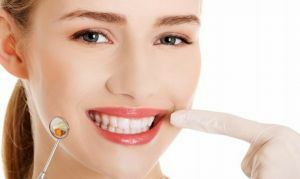 Beautiful wide smile and snow-white teeth - a business card of a healthy person who without a shade of embarrassment enters the conversation and laughs, not being afraid to show an even dentition.
Beautiful wide smile and snow-white teeth - a business card of a healthy person who without a shade of embarrassment enters the conversation and laughs, not being afraid to show an even dentition.
At the same time, communication with an interlocutor with dental problems( lack of or crooked teeth, inflamed gums, bad breath) is unlikely to be constructive, because such a person at a subconscious level causes rejection and reluctance to continue visual contact.
Bad teeth - this is an aesthetic problem that leaves an imprint both on the character( difficulties in communication, job search), and on human health.
Content
- Dental ABC
- How is tooth decay caries
- Why else would spoil
- teeth Chronic diseases
- Irrational nutrition
- Improper hygiene
- Genetic predisposition
- Lifestyle, and micronutrient deficiencies
- Malocclusion
- Bad habits
- crumbs, debris and dust tooth. ..
- Inrisk zone - children
- Why teeth get damaged during pregnancy
- Prevention of dental problems
StomatologicABC
Tooth - a separate body that has a specific form, equipped with nerve endings and blood vessels. Its purpose is to grind the food coming from outside and to participate in the articulation process.
The tooth consists of:
- of the anatomical crown , which protrudes from the jawed alveolus and is covered with enamel;
- root , hidden in the dental alveolus and attached to it by connective tissue;
- neck , which is a "border" between the visible part of the tooth( crown) and the root.
 The enamel is a layer of solid elongated formations that, like a matrix, extend along the entire surface of the tooth.
The enamel is a layer of solid elongated formations that, like a matrix, extend along the entire surface of the tooth.
Its thickness in different parts of the tooth varies between 0.01 and 1.5 mm. Enamel is covered with a special transparent pelicula, which is resistant to the influence of aggressive factors( acids, saliva).
Under the enamel "dentine", consisting of many "glued" collagen filaments, "hides".The space between such fibers is filled with mineral salts( calcium, magnesium, sodium).
In the dental crown there is a cavity( pulp), which is a connective tissue, penetrated by a network of blood vessels and nerves. The fixation of the root of the tooth to the tooth cavity is carried out by means of periodontal disease.
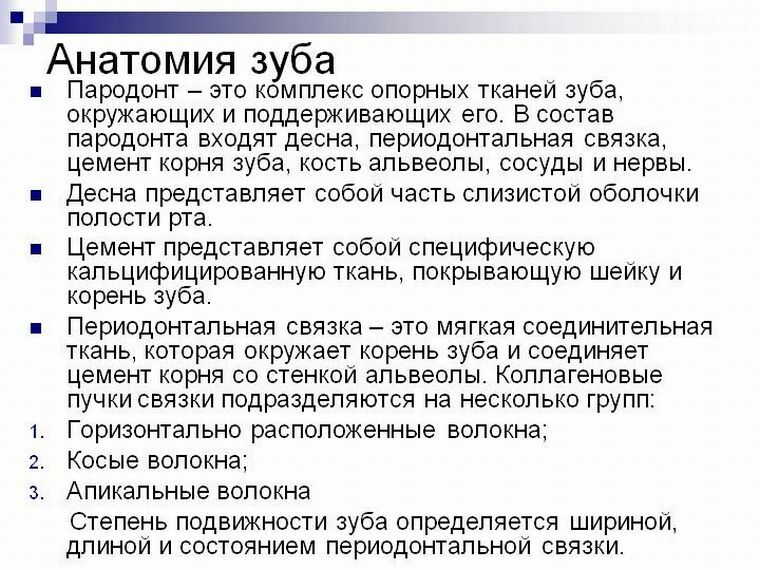
How tooth decay occurs
tooth decay The most common cause of tooth decay is the development of caries, a pathological process that leads initially to the demineralization of the enamel layer, and then to the appearance of characteristic cavities in the dentin.
Symptoms of tooth damage include:
- change in the shade of the enamel, the appearance of petty spots;

- detection of uncharacteristic roughnesses on the dental crown, "hooks" and "chips", delaying food residues;
- statement of unpleasant sensations associated with the use of hot or cold food;
- the appearance of nocturnal aching pain;
- visible "dips" and carious voids;
- occurrence of erasure of a dentition and change of an occlusion.
There are such types of caries:
- initial ( stain stage), proceeds almost asymptomatically, due to a lack of salts of Ca, leads eventually to a tissue defect in the spot area;
- surface , in which the cavity is located within the enamel, there are complaints of increased sensitivity to stimuli;
- is the average , when dentin is involved in the pathological destructive process;
- deep , when the patient marks regular pains in response to mechanical or thermal stimuli, a large cavity-hole is visualized on examination, filled with softened dentin. In the worst case, pulpitis or periodontitis is attached.
 In time, the treated tooth retains its properties and aesthetic value.
In time, the treated tooth retains its properties and aesthetic value.
However, in the absence of dental care caries leads to spoilage and tooth loss and provokes many problems: the appearance of gastritis, the development of pyelonephritis and tonsillitis( due to the constantly present infection in the body), etc.
Why the teeth of
still deteriorate The damage of teeth is the result of several damaging factors. So, external stimuli are released that ultimately lead to the thinning of the enamel and the appearance of caries:
- mechanical , leading to deformation of the tooth and violating its integrity( these are strokes, erasing, pressing);
- chemical ( sweet, sour), with prolonged exposure provoke "weakening" of the enamel;
- temperature , when the tooth is subjected to stressful effects of contrasting temperatures, which is fraught with the appearance of microcracks.
There are other causes of tooth decay.
Chronic diseases
Often, teeth are broken and broken due to such problems:
- The presence in the history of gastritis with high acidity makes a person vulnerable to caries development. The fact is that
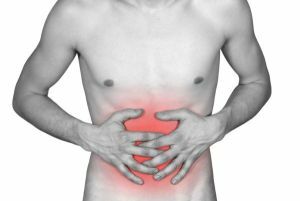 chemical substances that make up the gastric secretion, interfere with the body's absorption of calcium and phosphorus salts necessary to maintain "dental immunity".As a result, an artificial "holodomor" is brewing, the enamel becomes thinner and loses its protective properties.
chemical substances that make up the gastric secretion, interfere with the body's absorption of calcium and phosphorus salts necessary to maintain "dental immunity".As a result, an artificial "holodomor" is brewing, the enamel becomes thinner and loses its protective properties. - Hypertension - provoking the activation of caries factor. Patients suffering from high blood pressure are forced to take antihypertensive medications that cause hypofunction( decreased activity) of the salivary glands. This leads to the appearance of dryness in the oral cavity, and insufficient "washing" of the dental crown leads to the fact that microorganisms successfully penetrate through the cracks of the enamel inside the tooth, where caries develop. Exactly the same action has hypnotics, antihistamines, sedatives and antidepressants.
- Metabolic disorders , associated with thyroid diseases, diabetes mellitus, menopause in women leads to demineralization of the enamel layer of the tooth.
Unsustainable food
The state of teeth affects food preferences and the balance of human nutrition. The scantiness of food on minerals, especially calcium and phosphorus salts, will inevitably lead to the destruction of teeth.
 So, the increased consumption of foods saturated with calcium( hard cheese, sesame, bran, cheese, milk, cottage cheese, greens, beans) and phosphorus( fish, cottage cheese, cod liver, shrimp, squid, beet, carrot) helps to "freeze" the pathologicalprocess of tooth decay.
So, the increased consumption of foods saturated with calcium( hard cheese, sesame, bran, cheese, milk, cottage cheese, greens, beans) and phosphorus( fish, cottage cheese, cod liver, shrimp, squid, beet, carrot) helps to "freeze" the pathologicalprocess of tooth decay.
At the same time, the predominance of white flour products( bread, pies), sweets, protein products and purified cereals in the diet contributes to the development of dental problems.
The habit of getting rid of thirst through carbonated beverages( with dye) and juices only harms the health of teeth, while the consumption of purified( not boiled) water helps to clean the oral cavity of the plaque and food particles.
Improper hygiene
Insufficient or incorrect hygiene of the oral cavity provokes the development of caries and other dental diseases, because of the 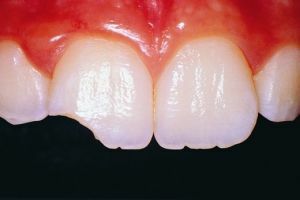 which breaks the teeth.
which breaks the teeth.
So, the remains of food stuck between the teeth become a "refuge" for pathogens, which at times increases the likelihood of an early meeting with the dentist.
Regular cleaning( twice a day) using quality pastes and anatomically correct toothbrush will help to minimize the risk of caries development.
In this case, the brush is recommended to be changed regularly( every 3 months), and alternate the appearance of the toothpaste.
The process of cleaning teeth should resemble sweeping, from the root to the top and last at least 3 minutes. Do not neglect the use of dental floss or toothpicks to clean the dental pockets of food debris and plaque.
Genetic predisposition
The composition of saliva, the shape and size of the teeth, the thickness of the enamel - all this is programmed long before birth. If the parents suffered from dental diseases, then their children are not immune from the predisposition to such ailments.
However, the genetic factor is not considered fundamental, so preventive measures will help prevent tooth loss at a young age.
Lifestyle and lack of microelements
Deficiency of calcium and phosphorus salts provokes a decrease in the quality of enamel. Replenishment of these and other micronutrients and vitamins is possible by consuming vitamin complexes or foods rich in calcium and phosphorus.
At the same time, calcium is absorbed only if there is sufficient vitamin D, which is produced by exposure to direct sunlight.
Regular day walks, active physical exercises - all this positively affects not only the general state of human health, but also on his teeth.
Incorrect bite of
If the dentition is uneven, jaws do not fit properly, this leads to enamel enamel of the dental crowns subjected to excessive pressure. As a result, it becomes thinner, and the teeth simply break off due to excessive load.
Bad habits
Excessive addiction to alcoholic beverages does not contribute to the preservation of teeth. Together with alcohol from the body are derived and useful substances( calcium, magnesium, sodium).
Regular smoking leads to the formation of a "nicotine" film on the tooth surface, under which microbes actively multiply and feel themselves.
Crumbs, splinters and dusty tooth. ..
Teeth crumble and break due to: 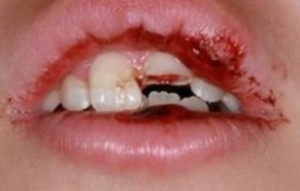
- mechanical injuries( strokes);
- damaging effect of thermal stimuli( microcracks appear, through which the infection penetrates into the bone tissue, the carious process proceeds imperceptibly);
- in the absence of the necessary hygiene and poor nutrition( a lack of trace elements causes the softening and thinning of the enamel);
- change in hormonal status( pregnancy, menopause, adolescence);
- development of certain diseases( arthritis, osteoporosis, diabetes);
- uncorrected in childhood, bite and bruxism( nocturnal scraping) provoke a violation of the integrity of the dental crown.
In the risk zone - children
Today, an unfavorable trend develops when only the child's teeth that have been cut through the baby are crumbling and carious processes develop right before our eyes.
This is due to:
- the impact of damaging factors in the stage of fetal development( severe toxicosis in pregnant women, unbalanced or malnourished mother, taking some medications);
- for antibiotic therapy in early( up to one year) age;

- lack of care for the first teeth, when the baby refuses to open the mouth for hygienic procedures;
- malnutrition, abuse of night feeds using sweet drinks( compote, sweetened water);
- of artificial feeding, because in the mixtures contains more than in breast milk the amount of carbohydrates;
- genetic predisposition in case of non-compliance with preventive hygiene measures( licking of the baby's teat or spoon, lack of individual cutlery).
At the same time, pathological processes develop simply with lightning speed due to the fact that the pulp in the milk teeth has a larger volume. This speeds up the process of infection and provokes the development of inflammation.
Why the teeth are damaged during pregnancy
During pregnancy, the future mother's organism undergoes enormous loads connected with the need to provide growing crumbs with vitamins and microcells necessary for growth.
The stores of calcium, phosphorus, sodium, etc. accumulated in a favorable period come first of all to the fetus, which can lead to a deficiency in the pregnant woman of certain trace elements. This can cause caries on healthy teeth during the period of gestation.
In addition, at this time, the acid-base composition of saliva is increased in the direction of increasing acidity, which creates an additional burden on bone tissue.
Prevention of dental problems
Distressed teeth are the trouble of many people, because getting rid yourself without the help of a dentist can not be prevented from caries.
However, there is a list of activities that help prevent the development of pathological processes of tooth decay:
- regular oral hygiene prevents the colonization of precious units by pathogenic bacteria;

- food, enriched with calcium, magnesium, phosphorus salts , etc., prevents the appearance of micronutrient deficiencies that support dental health;
- teeth are an inseparable part of the body, therefore in the treatment of chronic or newly acquired diseases is recommended not to forget about the visit to the dentist;
- elimination of such dental problems , as a violation of bite, gingivitis, periodontitis, reduces the likelihood of tooth loss;
- reception of multivitamin complexes with a sufficient calcium content prevents the thinning of enamel;
- daily repeated rinsing of the oral cavity of with herbal decoctions, ready-made rinses or simply running water reduces the risk of caries development;
- exclusion of the tooth-injuring action of ( alternating cold and hot food, opening of lids by means of teeth) prevents the appearance of cracks followed by the development of carious cavities.
Unlike other bone tissues, teeth are deprived of self-healing and, accordingly, are subject to wear and tear over time.
Increased attention and constant care will help prevent the development of dental problems and keep a beautiful smile.
